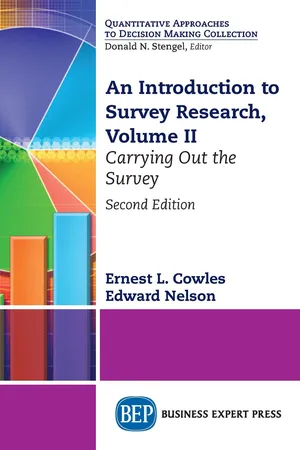
An Introduction to Survey Research, Volume II
Carrying Out the Survey
- 138 pages
- English
- ePUB (mobile friendly)
- Available on iOS & Android
About this book
Survey research is a powerful tool to help understand how and why individuals behave the way they do. Properly conducted, surveys can provide accurate insights into areas such as attitudes, opinions, motivations, and values, which serve as the drivers of individual behavior.
This two-volume book is intended to introduce fundamentals of good survey research to students and practitioners of the survey process as well as end-users of survey information. This second volume focuses on carrying out a survey— including how to formulate survey questions, steps that researchers must use when conducting the survey, and impacts of rapidly changing technology on survey design and execution. The authors conclude with an important, but often neglected aspect of surveys—the presentation of results in different formats appropriate to different audiences.
Frequently asked questions
- Essential is ideal for learners and professionals who enjoy exploring a wide range of subjects. Access the Essential Library with 800,000+ trusted titles and best-sellers across business, personal growth, and the humanities. Includes unlimited reading time and Standard Read Aloud voice.
- Complete: Perfect for advanced learners and researchers needing full, unrestricted access. Unlock 1.4M+ books across hundreds of subjects, including academic and specialized titles. The Complete Plan also includes advanced features like Premium Read Aloud and Research Assistant.
Please note we cannot support devices running on iOS 13 and Android 7 or earlier. Learn more about using the app.
Information
- Chapter 1—Introduction—Interviewing isn’t the only way we can obtain information about the world around us. We can also observe behavior. We compared observation and interviewing as two different methods of data collection. We also looked at a brief history of social surveys.
- Chapter 2—Sampling—What are samples and why are they used? In this chapter, we discussed why we use sampling in survey research, and why probability sampling is so important. Common types of samples are discussed along with information on choosing the correct sample size and survey approach.
- Chapter 3—Total Survey Error—Error is inevitable in every scientific study. We discussed the four types of survey error—sampling, coverage, nonresponse, and measurement error, focusing on how we can best minimize it.
- Chapter 4—Factors to Consider When Thinking about Surveys—In this chapter some of the fundamental considerations about surveys were presented: the stakeholders and their roles in the survey process; ethical issues that impact surveys; factors that determine the scope of the survey; and how the scope, in turn, impacts the time, effort, and cost of doing a survey.
- Chapter 5—Modes of Survey Delivery—There are four basic modes of survey delivery—face-to-face, mailed, telephone, and web delivery. We focused on the critical differences among these different modes of delivery and the relative advantages and disadvantages of each. We also discussed mixed-mode surveys, which combine two or more of these delivery modes.
- Chapter 2—Writing Good Questions—Here we look at survey questions from the perspective of the researchers and the survey participants. We focus on the fundamentals of the design, formatting, and wording of open- and closed-ended questions and discuss some of the most commonly used formats in survey instruments.
- Chapter 3—Carrying Out the Survey—Every survey goes through different stages, including developing the survey, pretesting the survey, administering the survey, processing and analyzing the data, reporting the results, and making the data available to others. Surveys administered by an interviewer must also pay particular attention to interviewer training.
- Chapter 4—Changing Technology and Survey Research—The chapter focuses on the impacts technology has had on survey research. As computers became widely available to the general public, survey platforms adapted to self-administered formats. Likewise, as cell-phone technology replaced landline telephones, survey researchers had to adapt to new issues in sampling methodology. Currently, rapid advances in mobile technology drive both opportunities and challenges to those conducting surveys.
- Chapter 5—Presenting Survey Results—In this chapter we talk about the last step in the survey process—presenting the survey findings. Three major areas, the audience, content, and expression (how we present the survey), which shape the style and format of the presentation, are each discussed along with their importance in the creation of the presentation. The chapter concludes with a discussion on how different types of presentations such as reports, executive summaries, and PowerPoints can be structured and how survey data and results can be effectively presented.
- Matilda White Riley’s Sociological Research I: A Case Approach is an early but excellent discussion of research design.8 Her paradigm of the 12 decisions that must be made in constructing a research design includes the alternative methods of collecting data—observation, questioning, and the combined use of observation and questioning.
- Earl Babbie’s The Practice of Social Research is a more recent introduction to the process of constructing a research design.9
- Delbert Miller and Neil Salkind’s Handbook of Research Design & Social Measurement provides many examples of the components of the research design.10
- Raymond Gorden’s Interviewing: Strategy, Techniques, and Tactics is one of the clearest discussions of the communication process and the factors that affect this process.11
- Norman Bradburn’s article “Surveys as Social Interactions” is an excellent discussion of the interactions that occur in interviews.12
Table of contents
- Cover
- Half Title Page
- Title Page
- Copyright
- Contents
- Preface
- Acknowledgments
- Chapter 1 Introduction
- Chapter 2 Writing Good Questions
- Chapter 3 Carrying Out the Survey
- Chapter 4 Changing Technology and Survey Research
- Chapter 5 Presenting Survey Results
- Notes
- References
- About the Authors
- Index